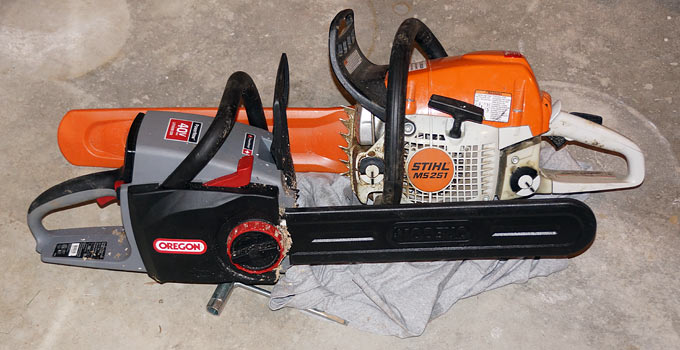Chainsaw Introduction for the Preparedness-Minded

(Ken’s Stihl chainsaw (and my new battery powered electric))
Guest article by Bogan
Why a Gas powered Chainsaw?
This article is tailored toward a preparedness-minded individual who has little to no exposure to the gas (petrol) powered chainsaw, but who foresees the need.
Pros: They make short work of big projects involving wood: downing trees, clearing roads (getting home or to your BOL), firewood and more.
Cons: They make noise and smell – which may attract undesirable attention after WROL hits. Also, like any gas powered machinery, they take a bit of work to maintain.
[Ken adds:] I will be posting on my 40-volt cordless (Oregon 16″) chainsaw in a future article. So far, love it. I don’t consider it a replacement though for a gas powered chainsaw. It’s complimentary. Will serve well for a fueless SHTF.
There are alternatives to a gas powered chainsaw: Electric chainsaws and manual saws. One article here on MSB featured old fashioned crosscut saws, which are excellent; however bow type saws are also an option especially on smaller trees and limbs. Bow saws are available online and in big box stores for twenty bucks or even less. Since they are a lot more work and slower than a gas powered chainsaw, they are perhaps most useful after WROL arrives.
Your First Chainsaw: What type?
For the person considering a first chainsaw that will have the maximum utility, the first question is what general specifications to look for? After all there are hundreds of chainsaws out there from which to chose, the question is which features are important?
Recommendations
My recommendations based on a number of years at this and lots of different saws are as follows:
Engine: Approx 35-50 cc engine size
Bar size: 16” bar, more or less (but no less than 14” and no more than 20”, the 16” bar really is about ideal).
Weight is a factor. A basic rule of thumb to follow is the stronger the saw the better it will cut, however the stronger the saw the more it will weigh, and the more it weighs the more it will tire out the user. A saw with these specifications provides a balance between efficiency and wearing out the user.
A saw this size will cut soft and hardwood trees up to about 30 inches in diameter, although if one is collecting firewood the vast majority of cuts will be significantly smaller. In my opinion, for most folks a saw with these specifications should handle 80% or more of the tasks they are confronted with.
Chainsaw price range
What about price?
A saw with these specifications can be had in the following price ranges:
Low: $100- $150 range. Available at big box stores at competitive prices. Poulan is a big name in this price point, and I have had several over the years, but have given them away. I consider these entry level saws.
Medium: $200-$400 range, these are saws often found with names such as “Homeowner” “Farm” “Rancher”. Popular brands are Stihl (model MS 250 fits the above spec), Echo, Husqvarna (model 240), and Jonsereds. These are an intermediate level saw.
Premium: $500 and up: Stihl, Husqvarna “Professional” saws
My choice? The Stihl MS261 – about $580.
If I could only have one saw (a forbidding thought!) this would be it. In my opinion it’s like a smooth handling .30-06 if you were limited to hunting with one rifle. It’s expensive, but buy once, cry once, right?
Chainsaw Equipment
Support equipment?
Gas – use non-ethanol or otherwise treat your gas with products such as Stabil or PRI-G
[Ken adds:]I use PRI-G due to more apparent favorable technical details. It’s also up to 3x less expensive per treated gallon (more concentrated) than Stabil. Depends on prices of course. That said, both work! Use it!
Oil
Bar Greasing tool (like this one). Some bars have a lubrication port around the nose sprocket, others get greased through the openings in the bar once the chain is removed.
File set for sharpening chains. Buy a sharpening kit that matches the pitch of your chain. Look for an engraved label on the side of your bar for correct chain / pitch.
.325 Chain Sharpening Kit
Bar dressing tool (to keep edges nice and square)
Bar vise
Chainsaw Safety Equipment
– Chaps
– Helmet (eyes/ears)
– Steel toe boots
– Leather gloves
Safety Helmet and Hearing Protection System
Functional Saw Protection Gloves
[Ken adds:] Do not ignore chainsaw safety! This tool (and tree work in general) can kill you. I live up in northern NH and bought all my safety gear from Labonville, world renown for their Chaps made locally.
Labonville Safety Chaps
Chainsaw Spare Parts
– Chains
– Plugs
– Air filters
– Bars
– Pull cord material
– Carburetor or tune up kits (Amazon is amazingly inexpensive on these, I just bought an aftermarket full tune up kit containing new carburetor, internal tubing, air filter, plug, gas filter, and priming bulb for an Echo arborist saw for under $17!)
Keep them clean and serviceable and a good saw will last for decades. I have a saw I bought new in 1983 (still have the receipt!) and still runs great. Pay most attention to clean gas and oil, air filters, keeping the chain sharp (keep it away from the ground!), fresh spark plugs and everywhere where the bar comes in contact with the rest of the saw (Remove bar to sweep/clean out what’s beneath).
So there you have it – one person’s view on the topic.
What Do You Use And Why?
-Bogan
